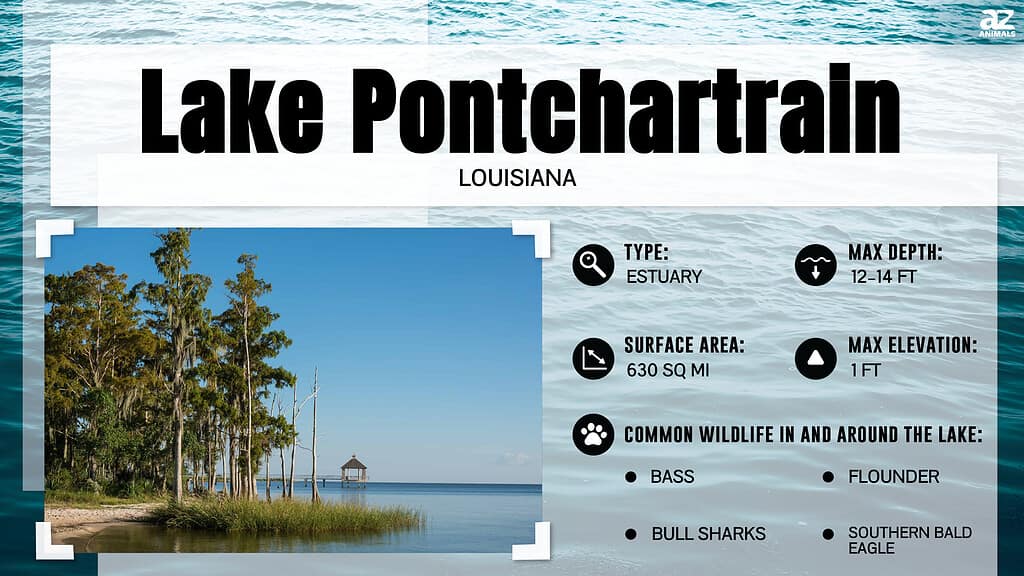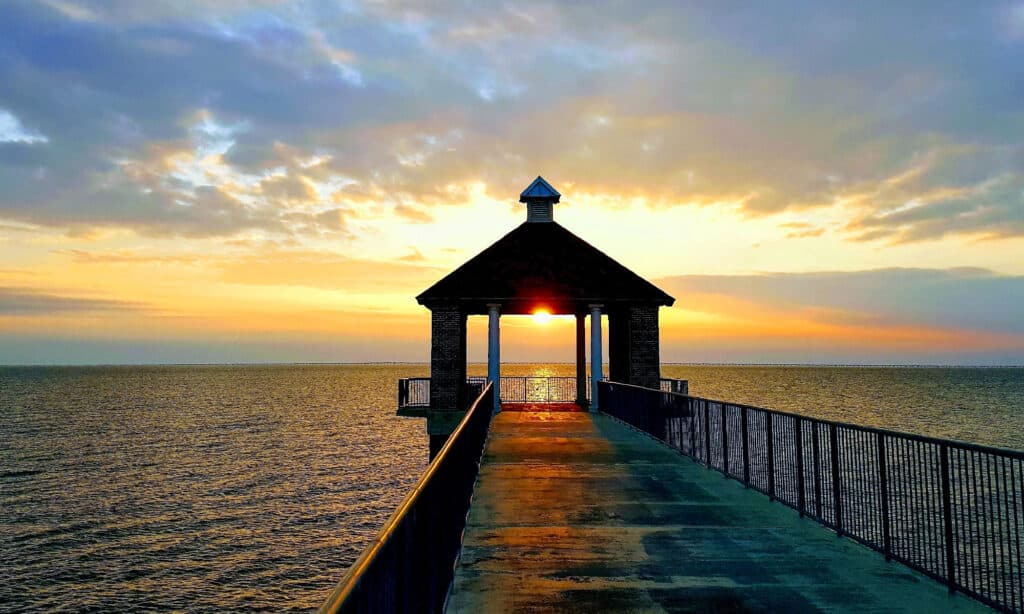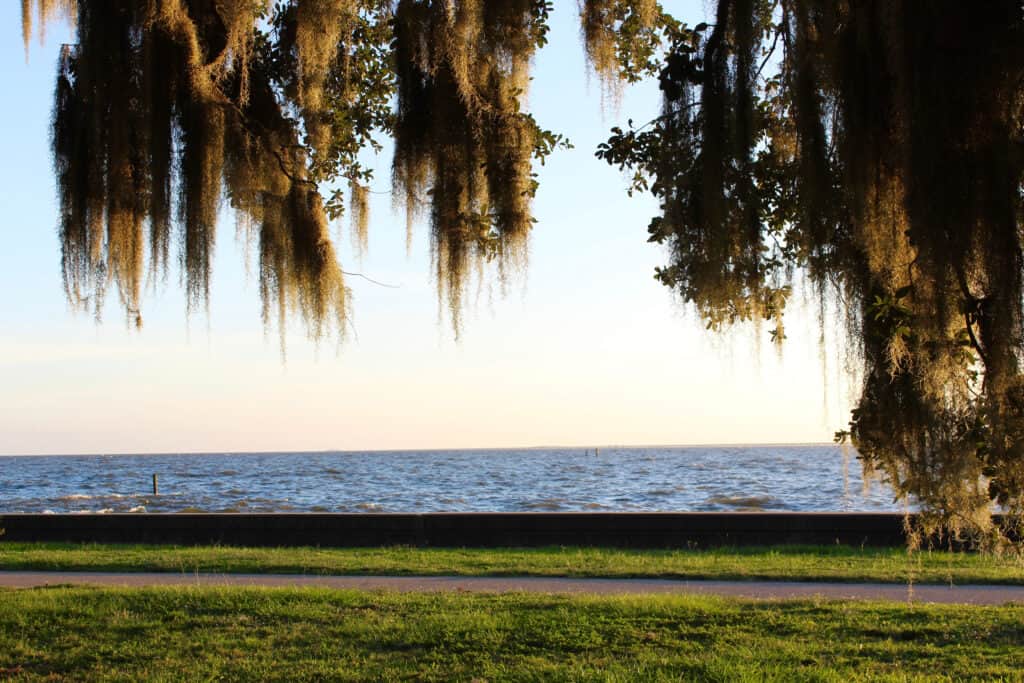Lake Pontchartrain isn’t actually a lake; it’s an estuary covering 630 square miles in Southeastern Louisiana. It is the largest body of water in the state and the second-largest inland saltwater body in the country. It is also home to the world’s longest continuous bridge over water. The Lake Pontchartrain Causeway is two parallel bridges crossing the lake for 24 miles, taking between 25 and 45 minutes to cross, depending on traffic. The causeway is so long it’s been used to demonstrate the curvature of the earth! Along with breaking several world records, Lake Pontchartrain is a place for families and recreators to enjoy outdoor activities. Discover all there is to know about this lake, including its location, history, size, depth, and activities!

Lake Pontchartrain Location
Lake Pontchartrain is located in Southeastern Louisiana, about a 20-minute drive from the French Quarter. This estuary is connected to the Gulf of Mexico by the Rigolets (long deepwater strait) and Chef Menteur Pass (a natural waterway) into the Lake Borgne lagoon. The north shore includes several towns like Mandeville, Abita Springs, Madisonville, Covington, Kentwood, and Slidell. New Orleans dominates the south shore region. The estuary forms the city’s northern boundary. The Lake Pontchartrain Causeway connects the New Orlean’s suburb of Metairie to Mandeville on the north shore.

The Lake Pontchartrain Causeway of Louisiana, 23.9 miles long, is the longest bridge in the United States.
©Mark Runde/Shutterstock.com
Lake Pontchartrain History
Native Americans began inhabiting the region around 3,500 years ago and lived near the water for centuries. They named the water “Okwata,” which means “wide water.”
Europeans arrived in 1699, and French settler, Pierre La Moyne, renamed the water Lake Pontchartrain after the French minister, Comte de Pontchartrain.
The area was used as an oil drilling site for over 30 years in modern times, which caused major pollution. Estuarine wetlands are in dire need of protection. An oil drilling moratorium has since been put in place. Due to extreme pollution, people were not allowed to swim in the lake’s waters. It took two decades to once again make the lake safe for swimming.

Lake Pontchartrain is the second-largest saltwater lake in the United States known for exceptional
catfish
and speckled trout fishing.
©iStock.com/Idylle Images
Lake Pontchartrain Size and Depth
This large lake covers 630 square miles and is 40 miles wide. It is the largest body of water in Louisiana and also one of the largest in the country. It is the most significant wetland along the Gulf Coast, covering over 125,000 acres.
The water features an average depth of 12 to 14 feet. It reaches 65 feet at its deepest point, making it the second-deepest lake in Louisiana.
The estuary is shaped like an oval. The north shore to the south shore spans 24 miles and runs 40 miles from east to west.
Are you looking for the Lake Pontchartrain water level? Check out this site for up-to-date changes.
Lake Pontchartrain Geology
When North American glaciers began melting around 5,000 years ago, they shifted the Mississippi River eastward. The river deposited sediment into the Gulf, creating a delta. The wetland evolved over thousands of years as the large body of water broke off from the Gulf of Mexico.

Besides fishing, boating is another favorite pastime on Lake Pontchartrain. You can also spend the day kayaking, paddle boarding, or canoeing.
©ClearlyKatePhotography/Shutterstock.com
Lake Pontchartrain Fishing
Lake Pontchartrain offers a diverse array of aquatic wildlife. This estuary is connected to the Gulf of Mexico, which means you can see more than just your typical lake fish. You can find everything from alligators to bull sharks.
Fishing on the lake is open year-round, but the water changes consistently throughout the year. For instance, speckled trout can be abundant. However, when there is too much freshwater during the summer, they swim away to find higher salinity concentrations. People also enjoy fishing for bass, redfish, flounder, catfish, sheepshead, and Atlantic croaker. You can either fish on your own or pick one of the many fishing charters.
Lake Pontchartrain Boating and Other Activities
Besides fishing, boating is another favorite pastime on Lake Pontchartrain. You can charter a boat, go on a guided boat tour, or spend the day kayaking, paddle boarding, or canoeing. Its waters are also vast enough for sailboats and other ocean cruisers.
And if you prefer to stay ashore, spend the afternoon strolling the walking path that runs along the lake in Old Mandeville. You can also checkout the beautiful Tammany Trace Bike Trail or just take in the sights.
Lake Pontchartrain Camping
Several RV resorts operate around the lake. But the area is also home to several state parks that offer more traditional camping. Fontainebleau State Park has cabins, RV sites, and primitive camping. And Fairview State Park has over 100 sites, offering more enhanced, premium tent camping.
Where is Lake Pontchartrain Located on a Map?
If you are entering the New Orleans area from the west on Interstate 10, you will drive right along the southwestern shore of Lake Pontchartrain. FYI: there is a point on the Causeway when you can’t see land in any direction. A turnaround has been built at that spot for all the people who get too scared to drive any further!
The photo featured at the top of this post is © Mark Runde/Shutterstock.com
Thank you for reading! Have some feedback for us? Contact the AZ Animals editorial team.






